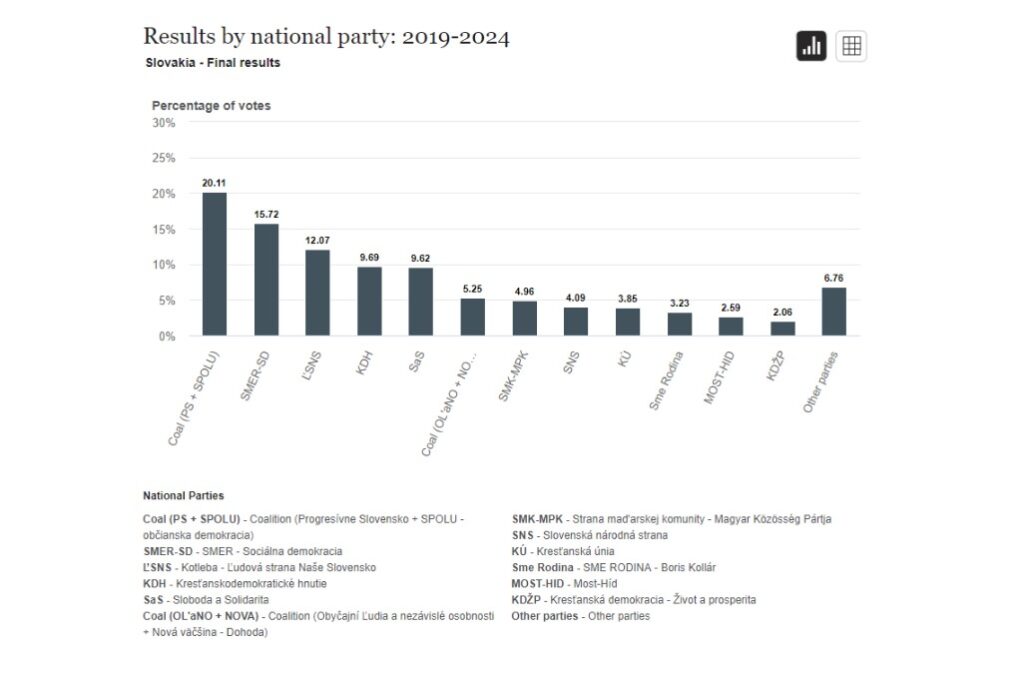Slovak European elections have brought some unexpected surprises.
These surprises will evidently have a significant impact on future parliamentary elections. Among the winners are the right-wing coalition of Progresívne Slovensko (Progressive Slovakia) and Spolu – Občianska demokracia (Together – Civil Democracy), right-wing extremists from ĽSNS (People’s Party Our Slovakia), as well as the KDH (Christian Democratic Movement), which announces its comeback.
On the contrary, the losers this time include left-wing parties as well as parties representing the Hungarian minority. After five years, the electoral participation has risen from 13% to about 22%, but as this trend was the same in other member states, Slovakia remained at the bottom of the unionEU.

What’s next, the left?
For the first time since 2006, the statewide elections were not won by the Smer-SD (Direction – Social Democracy), which this time ended second and gained 15.7% and three mandates. Thus, the European elections confirm the trend of two previous elections (municipal and regional), in which the party dominant in regions has lost several important positions. These failures result in deepening contradictions between the two main factions in the party – the first led by party chairman Robert Fico and the second led by Prime Minister Peter Pellegrini.
The coalition of a radical left – the KSS (Communist Party of Slovakia) and Vzdor – Strana práce (Resistance – Labour Party) – has not succeeded either. It was able to reach only 6 199 voters, which is 0.62%. It is interesting to note that in the past elections, when three radical left-wing parties – KSS, Vzdor (Resistance) and Úsvit (Dawn) – ran separately, they were able to gain about 2.3% altogether. The electoral participation was higher this year, but the two-party coalition was paradoxically able to reach even lower numbers of voters than in 2014.
SMER has been facing the long-term offensive of the right-wing opposition, the non-governmental sector, and the mainstream media. And the results of the last elections show that this offensive is effective. In addition, according to the KSS and Vzdor (Resistance), every other party scandal devaluates the name of the left and left-wing values in public awareness. Thus, in the context of the upcoming parliamentary elections, extremely difficult times for the Slovak left can be expected.
Domination of the right
The right-wing coalition of Progresívne Slovensko (Progressive Slovakia) and Spolu – Občianska demokracia (Together – Civil Democracy) replaced SMER in the electoral lead after many years. The right-wing tandem has gained the confidence of over 198 000 voters, which is 20.1%, and won four seats. However, in the European Parliament they will split into two factions – Progresívne Slovensko (Progressive Slovakia) will strengthen the liberal ALDE; Spolu (Together) will be with EPP.
The circle of right-wing parties in European Parliament from Slovakia has expanded by non-parliamentary KDH (Christian Democratic Movement) with a gain of 9.7% and two mandates (the party’s second mandate will be available after the UK’s departure from the EU), liberal SaS (Freedom and Solidarity) with 9.6% and two mandates as well, and the movement OĽaNO (Ordinary People and Independent Personalities), which just exceeded five percent (5.25%). It is interesting that Peter Pollák from OĽaNO will also be the first MEP of Roma nationality to represent Slovakia.
In the final sum, the right (if we do not count the extreme right) was able to obtain 9 of the 14 mandates that are earmarked for Slovakia.
Extreme right metastases uncontrollably
In an article describing the situation before the European elections, we have drawn attention to the fact that the question is not whether the right-wing extremists will get to the European Parliament for Slovakia, but whether they will get one or two mandates. The results confirmed the worse of the two options, and extreme right-wing ĽSNS (People’s Party Our Slovakia) received two mandates, reaching 12%. Their MEPs will join the APF faction.
Increase of the ĽSNS electorate is a long-term trend. In the parliamentary elections, Kotleba’s extremists won 8%, while in March’s presidential election the party leader won 10%, and in the European elections already 12%. In the previous European elections, they gained only 1.73%. Thus, the growth of right-wing extremism is becoming an increasingly serious problem for Slovakia.
European elections that (also) affect domestic policy
Given the results, the last European elections will also have a significant impact on domestic policy. Not only because the dominant SMER is losing ground. There are several reasons. It turns out that the Slovak public is starting to put their trust in the new opposition parties that have not yet participated in the last elections. This happens at the expense of the current opposition, which had higher ambitions in relation to the European elections. In the context of the current opposition, it is necessary to mention the fact that the radical movement Sme rodina – Boris Kollár (We Are Family – Boris Kollár) of entrepreneur Boris Kollár failed in these elections; even though it was supported by Marine Le Pen and Matteo Salvini just before the elections. The party only received 3.2%, which in the absence of a party leader on the electoral list means that the weight of electoral success will lie largely on Boris Kollar’s shoulders.
The parties that participate in the government together with Smer-SD also failed in these elections. The Slovenská národná strana (Slovak National Party) with 4.09% and the Hungarian party Most-Híd (Bridge) with 2.6% remained below the 5% threshold, which underlined the failure of the current government coalition. At the same time, it is a signal that these parties may not only say goodbye to governance after the next parliamentary elections, but will struggle to be represented in the parliament at all.
Strana maďarskej koalície (The Hungarian Coalition Party) also ended just below the 5% threshold (with a gain of 4.96% only 396 votes were needed for a mandate). The party which is in Slovakia considered to be the extended arm of Orban’s Fidesz has lost its representation in the European Parliament. And given that apart from Most-Hid and SMK, two other Hungarian parties have stood as candidates, it is clear that in relation to the March parliamentary elections, their joining will be on the programme of the day.
This parliamentary calculation will also take into account the parties of right-wing president Andrej Kiska and the populist Štefan Harabin. Despite the fact that they have not yet been created, both are likely to get into the parliament.
And in the middle of this political chess there is a weakened Slovak left. On the one hand, it is represented by the declining social democracy, whose falls are accompanied by political scandals, and on the other hand by the radical left, which after the division is gradually finding its way to unification, but without the desired results. If we add this to the fact that not only the party left, but also the non-party left is in crisis (in Slovakia there is no relevant left-wing medium, a functional left-wing think-tank, or a diverse spectrum of left-wing non-governmental organizations), we come to the necessity of restarting the left in Slovakia.



